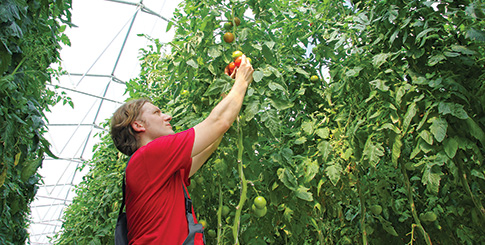On the construction side, using diffused glass instead of plastic can more evenly distribute sunlight. Lastly, another trend is building taller greenhouse structures, which reportedly can better manage temperature variations.
According to Wowryk, there has been greater emphasis on flavor profile over yields in recent years. “Consumers are looking for better-tasting produce and are willing to support those who are consistent in this area,” he asserts. “The best opportunity for anyone in the greenhouse industry is to pay attention to this trend.”
Although keeping tomatoes on the vine longer enhances flavor, many are harvested due to market demands. Nevertheless, it’s still a fine tomato. “We can take a so-so variety of tomato, and at the end of the day it can perform very well for flavor,” explains Wowryk. “It gathers its sugar and its sweetness on the vine, not trying to ripen up in a box.”
Color & Size Combinations
For tomatoes, in addition to the traditional red color, Leamington growers are cultivating orange, yellow, and even brown fruit. Size can range from small cocktail size to medium Romas to large beefsteak tomatoes. Older heirloom varieties are also back with rising consumer demand. For growers, it’s an expanding rainbow of opportunities.
“As you change the shape and the color, you are also looking at different flavors and tastes,” enthuses Khosla.
Peppers, too, come in a dizzying array of sizes, shapes, and colors—encompassing both sweet and hot varieties. Colors range from red, green, orange, yellow, and even brown, though not many growers favor the chocolate-colored peppers. For cucumber output, growers favor the traditional green but provide multiple sizes and flavors in seedless varieties.
Newer offerings from the Leamington industry are berries and various types of lettuce. Both greenhouse strawberries and lettuce are already on the market, according to Khosla. Some growers are also trying to cultivate caneberries, such as blackberries and blueberries. Depending on how well the berries perform in the marketplace, growers could expand production to keep pace with the highly popular berry market.
Outlook
Though the Leamington greenhouse industry has reason to be proud of its success, growers cannot be complacent. They must deal with the downsides of labor costs (including the alternative to human workers—more automation, which is costly to develop and implement) and provincial regulation (requiring growers to be even more energy efficient than now) and international trade (from NAFTA to global tariffs).
For the moment though, Khosla says, “The greenhouse sector in Ontario has been growing at about 6 percent annually for the last 10 years, and this seems to be continuing. From what I’ve heard, the number of acres going in will be another 6 percent this year.”
Image: branislavpudar/Shutterstock.com



